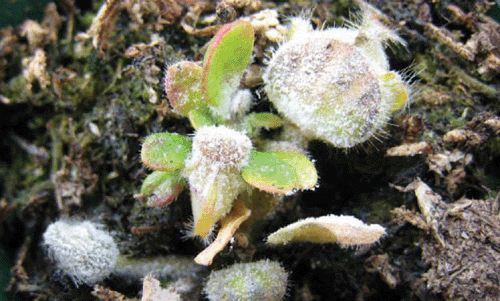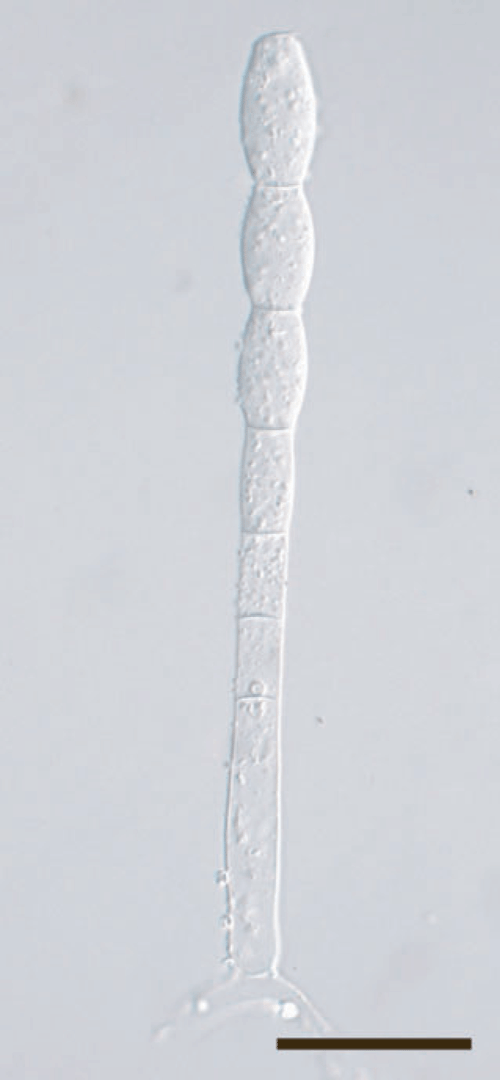First record of powdery mildew on the Cephalotaceae
J. H. Cunnington A B , Rodney H. Jones A and Sri Kanthi de Alwis AA Biosciences Research Division, Department of Primary Industries, Knoxfield, Private Bag 15, Ferntree Gully Delivery Centre, Vic. 3156, Australia.
B Corresponding author. Email: james.cunnington@dpi.vic.gov.au
Australasian Plant Disease Notes 3(1) 51-52 https://doi.org/10.1071/DN08021
Submitted: 21 January 2008 Accepted: 8 April 2008 Published: 17 April 2008
Abstract
Powdery mildew is reported for the first time on the Albany pitcher plant (Cephalotus follicularis). The plants originated from a nursery in Melbourne. The fungus was identified as Podosphaera xanthii using morphological characters and a rDNA ITS sequence. This is the first record of powdery mildew on the Cephalotaceae.
In September 2007 several pots of young Albany pitcher plants (Cephalotus follicularis) were submitted to the DPI Victoria Crop Health Services unit. The leaves (‘pitchers’) were covered with a powdery mildew fungus (Fig. 1). Microscopic examination of the fungus showed chains of ellipsoid to ovoid conidia, usually 26–35 × 15–18 µm, that contained fibrosin bodies (Fig. 2). The conidiophores were erect, the foot cells cylindrical with a slight constriction at the basal septum, and appressoria were indistinct. These characters were consistent with the plurivorous species Podosphaera xanthii, but also with the anamorphs of many other species of Podosphaera (Braun 1987; Braun et al. 2001). To confirm the identification, DNA sequencing was attempted.

|

|
Total DNA was extracted from several infected leaves using a DNeasy™ Plant Mini Kit (Qiagen). The rRNA internal transcribed spacer (ITS) region was amplified and sequenced using primers PM1 and PM2 (Cunnington et al. 2003). A similarity search of GenBank sequences revealed the sequence to be identical to, or a few bases different from, validated P. xanthii sequences (Braun et al. 2001; Hirata et al. 2000). It is identical to P. xanthii haplotype 27 designated by Hirata et al. (2000). The sequence is also identical to numerous P. fusca sequences on GenBank. However, many of these were submitted before Braun et al.’s (2001) taxonomic revision of Podosphaera sect. Sphaerotheca subsect. Magnicellulatae, based on the phylogenetic analysis of Hirata et al. (2000). Those submitted subsequently, most of which are not linked to any published papers, may not have taken this revision into account. The sequence obtained here has been deposited in GenBank as accession EU367960. A specimen has been deposited in the DPI Victoria Plant Pathology Herbarium as VPRI 41238.
Cephalotus is a monotypic insectivorous genus from south-west Western Australia, containing C. follicularis, commonly called the Albany pitcher plant (Erickson et al. 1973). It is also the only species in the Cephalotaceae. It occurs naturally in densely vegetated areas around swamps and streams. It produces two types of leaves, flat leaves and carnivorous leaves that are modified into pitchers. The pitchers are up to 5 cm long and contain a watery liquid in which insects drown and decompose. It was the pitcher lids that were most heavily affected by the powdery mildew.
This is the first record of a plant disease on this plant family. But, it is not surprising to find that it can be infected by P. xanthii. P. xanthii is a cosmopolitan plant pathogenic fungus recorded from a wide range of angiosperm plant families (Braun 1987; Braun et al. 2001). The Cephalotaceae can now be added to this list.
Braun U
(1987) A monograph of the Erysiphales (powdery mildews). Beiheft zur Nova Hedwigia 89, 1–700.

Braun U,
Shishkoff N, Takamatsu S
(2001) Phylogeny of Podosphaera sect. Sphaerotheca subsect. Magnicellulatae (Sphaerotheca fuliginea auct. s. lat.) inferred from rDNA ITS sequences – a taxonomic interpretation. Schlechtendalia 7, 45–52.

Cunnington JH,
Takamatsu S,
Lawrie AC, Pascoe IG
(2003) Molecular identification of anamorphic powdery mildew fungi. Australasian Plant Pathology 32, 421–428.
| Crossref | GoogleScholarGoogle Scholar |

Hirata T,
Cunnington JH,
Paksiri U,
Limkaisang S,
Shishkoff N,
Sato Y, Takamatsu S
(2000) Evolutionary analysis of subsection Magnicellulatae of Podosphaera section Sphaerotheca Erysiphales) based on the rDNA internal transcribed spacer sequences with special reference to host plant. Canadian Journal of Botany 78, 1521–1530.
| Crossref | GoogleScholarGoogle Scholar |



